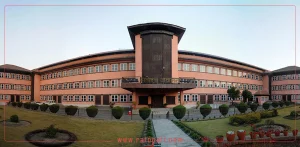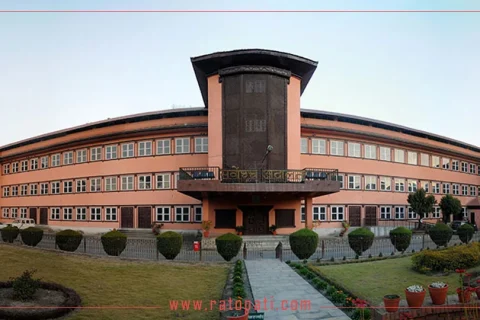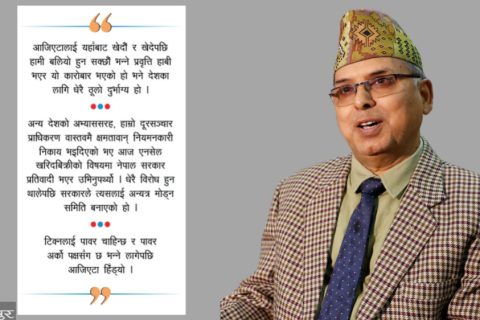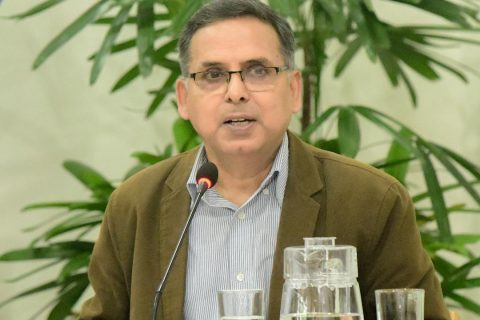The airport planned in Nijgadh, Bara, lies 175 kilometres south of the Capital.
A 3-2 ruling of the Supreme Court has quashed all government decisions made earlier for the development of a mega international airport in the southern Tarai plains.
The top court, however, has kept options open to construct the international airport, an alternative to Kathmandu’s Tribhuvan International Airport.
The full text of the verdict on the Nijgadh International Airport by an extended full bench comprising justices Hari Krishna Karki, Bishowambhar Prasad Shrestha, Ishwar Prasad Khatiwada, Prakash Man Singh Raut and Manoj Sharma was released by the court on Wednesday. The preliminary ruling was issued on May 26 after concluding the hearing process.
Shrestha, Khatiwada and Raut have ordered the authorities to build the airport by conducting a proper environmental impact assessment ensuring that the environmental damage is minimal.
The justices, however, have not specified where the new facility should be built.
The airport planned in Nijgadh, Bara, 175 kilometres south of the Capital, was deemed an alternative to Kathmandu’s Tribhuvan International Airport.
“While it is natural for any development activities to cause environmental degradation, every possible attempt must be made to find alternatives to minimise such degradation,” says the court order.
The government, on different occasions, had made three crucial decisions.
In March 2015, the Cabinet gave a go-ahead to the Tourism Ministry for demarcation of the boundary of the long-planned then Second International Airport in Nijgadh. The ministry had proposed delineating an area of 8,045.79 hectares [80 sq-km] for the proposed second international airport with two runways.
The government then began the process for environmental and social impact assessment.
The environmental and social impact assessment report submitted to the Tourism Ministry in February 2017 envisaged cutting more than 2.4 million small and large trees to build the airport.
The proposed airport in Bara, slated to become the largest in South Asia in terms of area, had been embroiled in a storm over its environmental impact.
Environmentalists then suspected the motive of the government months after it was found that the environmental impact assessment report was flawed. Some parts of the report had a hydropower component which later was exposed as “copied and pasted”.
The environmental and social impact assessment report submitted to the Tourism Ministry in February 2017 envisaged cutting more than 2.4 million small and large trees to build the airport.
The third key decision was made in September 2017 after the completion of the environmental and social impact assessment report.
The Civil Aviation Authority of Nepal, the project executing body, had assigned the Nepal Army to build access and perimetre roads and clear trees at the proposed construction site. The government had allocated Rs1.5 billion for this purpose.
The court has found the Environmental Impact Assessment report approved by the Ministry of Forest and Environment on May 23, 2018 to be erroneous and said the decision to fell trees on 8,045.79 hectares and other decisions taken as per the report were faulty.
The order doesn’t rule out the necessity of the construction of another international airport.
It, however, says while implementing such a mega project, the concepts of sustainable development, intergenerational justice and biodiversity protection should not be overlooked or undermined.
The selection of the area for the construction of the airport should be objective and logical, the court’s ruling reads.
While the environmental impact assessment should follow due legal procedures, the size of the airport and its capacity should be determined through proper consultations with environmentalists, wildlife experts, airport management experts, economists, sociologists and administrative experts with all possible alternatives to reduce damage and losses, according to the ruling.
Justices Karki and Sharma, however, have observed the need for building the airport within the Nijgadh area by ensuring minimal damage to the environment.
“It is a concurring verdict,” Bimal Poudel, spokesperson for the Supreme Court, told the Post. “The two justices have different opinions only in providing alternatives for the airport construction.”
Karki and Sharma, similar to the ruling, have said there has to be a minimal damage to environment and biodiversity while constructing the airport.
However, while the verdict doesn’t say where the airport should be constructed, they have suggested that the airport can be constructed in the same place with some changes in alignment so that fewer trees need to be felled.
“Conduct the study prioritising that the forest area remains intact by constructing the facility on public land, to the south of the proposed area that incorporates Tangiya basti [settlement],” reads their opinion. “If it is still necessary to chop trees from the jungle area, ensure that new saplings are planted as prescribed by the law and they are protected until they grow up.”
One of the three justices told the Post that the detailed order is clear in itself.
“Our observation is that initial decisions by the government could be detrimental to the environment. That’s why those decisions have been quashed,” the justice told the Post on condition of anonymity. “The judgement does not say an airport should be built in Nijgadh or not. What the judgement says is that the existing study is not enough.”
“What we have said is, first conduct the study by using all necessary experts and then build the airport wherever it is appropriate. This is what we have said [in the verdict],” added the judge.
“We, however, have said the way the land was allocated for the project was wrong. Since the government has allocated more forest land where more trees than necessary would have to be felled, we have annulled the decision for the reason that biodiversity would be adversely affected and the environment damaged,” he said.
“We cannot determine the alternative, which should be done by the experts. We have just said necessary technical experts should study and make the right decision. We have not said that an airport must not be built at Nijgadh if it is the best alternative to other places. But allocating an unnecessarily large jungle area was wrong. The condition is that the experts must find out the place where the environmental damage will be the least,” said the justice.
On December 6, 2019, Supreme Court Justice Tanka Bahadur Moktan had issued a stay order asking the government to immediately stop the felling of trees at the site, which a division bench of Chief Justice Cholendra Shamsher Rana and Justice Kumar Regmi upheld on December 22 that year.
Nine individuals, including environmentalist Ranju Hajur Pandey and former secretary Dwarika Nath Dhungel, had filed the writ petition.
The airport planned in Nijgadh, Bara, 175 kilometres south of the Capital, was deemed an alternative to Kathmandu’s Tribhuvan International Airport.
The Investment Board Nepal decided to move ahead with the project regardless of the court ruling and invited potential bidders to submit proposals, insisting that the court order only prevented them from felling trees and did not say that all work should be stopped.
In September 2019, the government shortlisted Zurich Airport International AG as a single company to work on a public-private partnership model for the construction of the airport.
The board had received letters of intent from eight companies based in seven countries, including Nepal. On January 17, 2020, the board formally asked Zurich Airport to submit a business proposal.
Under the public-private partnership modality of build, own, operate and transfer, the Swiss company would fully fund the construction.
Zurich Airport was required to state in the business proposal for how long it would operate the airport before handing it over to Nepal.
The last date for submitting the document was September 30, 2020; but following the court order, Zurich International Airport AG asked for a time extension.
The Swiss company made no further official communication after that.
An advocate who participated in the hearing says it is a landmark verdict towards the protection of the environment.
“The court doesn’t say the airport is not required,” senior advocate Dinesh Tripathi told the Post. “It only says don’t construct it in the proposed spot which may cause a huge loss to the environment and biodiversity.”
The airport can be shifted towards Simara or towards the south of the proposed area, he said.
“It’s a welcome decision,” said Sanjiv Gautam, former director general of the Civil Aviation Authority of Nepal.
“The 8,000 hectares is not required to construct the facility as proposed by the government. A modern facility could be constructed on 2,000 hectares which can host at least three runways if required in the future.”
“So, if the government opted to shift the airport to the south, it would reduce 75 percent of damage to the jungle in Bara,” said Gautam.
“That means, the number of trees that need to be felled would come down to a maximum 500,000 [around 200,000 big trees and 300,000 pole sized trees] from the earlier plan to cut 2.4 million,” said Gautam. “That will be justice for the environment too.”
Gautam said that as the public has almost “no trust” in the government, it should be ensured that compensatory tree plantation takes place before the airport is constructed.
The fate of the $3.45 billion Nijgadh International Airport [in three phases] had been hanging in the balance for years, with successive governments pushing for it and environmentalists resisting it equally fervently, citing massive damage to the environment, biodiversity, local communities and wildlife that the touted project would cause.
The first phase of the project is estimated to cost Rs120 billion as per the internal assessment of the Civil Aviation Authority of Nepal.
The proposed construction site lies adjacent to the Parsa National Park, which is a forest corridor for big wildlife like tigers and elephants, and home to rich biodiversity.
The entire area is blanketed in dense forests of Shorea robusta trees, also known as sal or sakhuwa.
The government has poured more than Rs2 billion into the project so far. According to Civil Aviation Authority officials, nearly Rs800 million has been distributed in compensation to the project-affected people.
The court has found the Environmental Impact Assessment report approved by the Ministry of Forest and Environment on May 23, 2018 to be erroneous and said the decision to fell trees on 8,045.79 hectares and other decisions taken as per the report were faulty.
Last year, the Civil Aviation Authority spent Rs300 million to prepare a revised master plan. The master plan too was drafted when the project’s future was in limbo causing huge losses to the government.
In 2018, the Civil Aviation Authority had started work to prepare an airport master plan and detailed design of the first phase of Nijgadh airport, but the scheme landed in controversy over potential misuse of around Rs700 million. It was then suspended as officials feared it might attract the attention of the anti-graft agency.
Again in January 2020, the national pride project under the authority invited expressions of interest from potential consultants for preparing an updated master plan for the airport.
But this time, the authority decided not to include the detailed design component. The detailed design is normally prepared by the company that wins the project contract. The plan too fell apart.
However, the Civil Aviation Authority prepared the master plan at Rs300 million last year taking advantage of Covid-19 when the entire nation’s attention was transfixed on the pandemic, according to the sources privy to the matter.
With this master plan, currently the government owns two documents. One document prepared by a South Korean company, however, remains unopened because the government has to pay for it to own it.
In April 2012, Landmark Worldwide Company of South Korea conducted a detailed feasibility study for the airport at a cost of $3.55 million and submitted its report to the government.
The costs, if added with inflation, currently would hover to more than Rs700 million, according to the Tourism Ministry sources.
In 1995, the government initiated discussions to construct a second international gateway in the plains as an alternative to Nepal’s only international airport in Kathmandu.
The decision followed two deadly aviation disasters involving Thai Airways and Pakistan International Airlines in the hills surrounding Kathmandu in 1992. This gave momentum to discussions on an alternate airport and how the difficult topography of Kathmandu poses a challenge for even experienced pilots to land.
The project remained on the drawing board for two decades, and gained renewed urgency after a Turkish Airlines aircraft skidded off the runway in Kathmandu in March 2015, causing the airport to remain closed for four days.
Legal experts say the judiciary has the authority to check the legal compliance and the Supreme Court has rightly done so in the Nijgadh airport’s case.
“The verdict is balanced, corrective and prescriptive,” Bipin Adhikari, a professor and former dean at Kathmandu University School of Law, told the Post. “It hasn’t intervened in the executive’s authority to decide where to construct the airport. It has only said due legal process needs to be followed strictly.”








